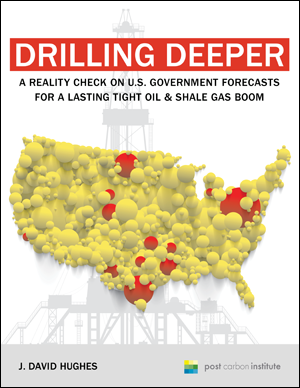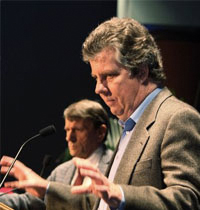
Drilling Deeper
October 27, 2014
Abstract
Drilling Deeper reviews the twelve shale plays that account for 82% of the tight oil production and 88% of the shale gas production in the U.S. Department of Energy’s Energy Information Administration (EIA) reference case forecasts through 2040. It utilizes all available production data for the plays analyzed, and assesses historical production, well- and field-decline rates, available drilling locations, and well-quality trends for each play, as well as counties within plays. Projections of future production rates are then made based on forecast drilling rates (and, by implication, capital expenditures). Tight oil (shale oil) and shale gas production is found to be unsustainable in the medium- and longer-term at the rates forecast by the EIA, which are extremely optimistic.
This report finds that tight oil production from major plays will peak before 2020. Barring major new discoveries on the scale of the Bakken or Eagle Ford, production will be far below the EIA’s forecast by 2040. Tight oil production from the two top plays, the Bakken and Eagle Ford, will underperform the EIA’s reference case oil recovery by 28% from 2013 to 2040, and more of this production will be front-loaded than the EIA estimates. By 2040, production rates from the Bakken and Eagle Ford will be less than a tenth of that projected by the EIA. Tight oil production forecast by the EIA from plays other than the Bakken and Eagle Ford is in most cases highly optimistic and unlikely to be realized at the medium- and long-term rates projected.
Shale gas production from the top seven plays will also likely peak before 2020. Barring major new discoveries on the scale of the Marcellus, production will be far below the EIA’s forecast by 2040. Shale gas production from the top seven plays will underperform the EIA’s reference case forecast by 39% from 2014 to 2040, and more of this production will be front-loaded than the EIA estimates. By 2040, production rates from these plays will be about one-third that of the EIA forecast. Production from shale gas plays other than the top seven will need to be four times that estimated by the EIA in order to meet its reference case forecast.
Over the short term, U.S. production of both shale gas and tight oil is projected to be robust-but a thorough review of production data from the major plays indicates that this will not be sustainable in the long term. These findings have clear implications for medium and long term supply, and hence current domestic and foreign policy discussions, which generally assume decades of U.S. oil and gas abundance.
Read the Report in Parts
Part 1: Executive Summary Part 2: Tight Oil Part 3: Shale Gas Full Report
About the Author
J. David Hughes is a geoscientist who has studied the energy resources of Canada for nearly  four decades, including 32 years with the Geological Survey of Canada as a scientist and research manager. He developed the National Coal Inventory to determine the availability and environmental constraints associated with Canada’s coal resources.
four decades, including 32 years with the Geological Survey of Canada as a scientist and research manager. He developed the National Coal Inventory to determine the availability and environmental constraints associated with Canada’s coal resources.
As Team Leader for Unconventional Gas on the Canadian Gas Potential Committee, he coordinated the recent publication of a comprehensive assessment of Canada’s unconventional natural gas potential. Over the past decade, he has researched, published and lectured widely on global energy and sustainability issues in North America and internationally.
He is a board member of the Association for the Study of Peak Oil and Gas – Canada and is a Fellow of the Post Carbon Institute. He recently contributed to Carbon Shift, an anthology edited by Thomas Homer-Dixon on the twin issues of peak energy and climate change, and his work has been featured in Nature, Canadian Business, and other journals, as well as through the popular press, radio, television and the internet. He is currently president of a consultancy dedicated to research on energy and sustainability issues.







